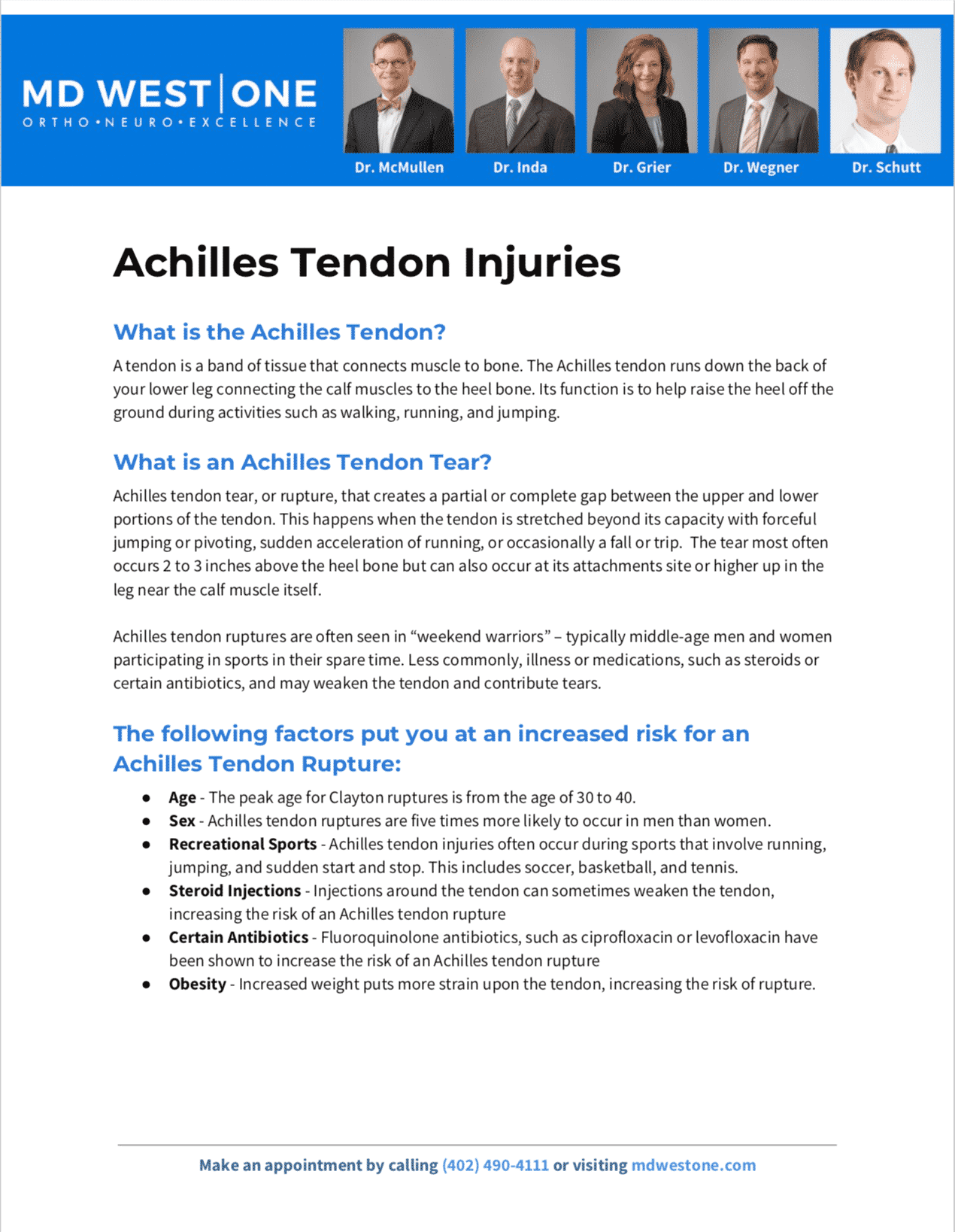Are you suffering from Foot Tingling?
The Omaha Foot & Ankle Specialists at MD West ONE are able to properly diagnose and treat foot tingling through both surgical and non-surgical treatments. If you have the following symptoms, you may want to make an appointment with one of our Board Certified Specialists.
- Tingling (“pins and needles”) or numbness, sensations can spread to the legs
- Sharp, burning, throbbing, stabbing, or electric-like pain
- Changes in sensation. Severe pain, especially at night. Inability to feel pain, pressure, temperature, or touch. Extreme sensitivity to touch
- Falling, loss of coordination
- Not being able to feel things in your feet – feeling like you are wearing socks when you are not
- Muscle weakness, difficulty walking or moving your legs
- Muscle twitching, cramps, and/or spasms
Meet MD West ONE's foot and ankle specialists and learn more about how they treat foot tingling.
Foot Tingling Causes, Treatments & Surgery
What is Foot Tingling?
Neuropathy, often called peripheral neuropathy, indicates a problem within the peripheral nervous system. Your peripheral nervous system is the network of nerves outside your brain and spinal cord. Your brain and spinal cord make up your central nervous system. Think of the two systems working together this way: Your central nervous system is the central station. It is the control center, the hub from which all trains come and go. Your peripheral nervous system are the tracks that connect to the central station. The tracks (the network of nerves) allow the trains (information signals) to travel to and from the central station (your brain and spinal cord).
Neuropathy results when nerve cells, called neurons, are damaged or destroyed. This disrupts the way the neurons communicate with each other and with the brain. Neuropathy can affect one nerve (mononeuropathy) or nerve type, a combination of nerves in a limited area (multifocal neuropathy) or many peripheral nerves throughout the body (polyneuropathy).
The following factors put you at an increased risk for Foot Tingling:
Foot tingling is not caused by a single disease. Many conditions and events that impact health can cause foot tingling, including:
- Diabetes: This is a leading cause of foot tingling in the United States. Some 60% to 70% of people with diabetes experience foot tingling. Diabetes is the most common cause of small fiber foot tingling, a condition that causes painful burning sensations in the feet.
- Trauma: Injuries from falls, car accidents, fractures or sports activities can result in foot tingling. Compression of the nerves due to repetitive stress or narrowing of the space through which nerves run are other causes.
- Autoimmune disorders and infections: Guillain-Barré syndrome, lupus, rheumatoid arthritis, Sjogren’s syndrome and chronic inflammatory demyelinating polyneuropathy are autoimmune disorders that can cause foot tingling. Infections including chickenpox, shingles, human immunodeficiency virus (HIV), herpes, syphilis, Lyme disease, leprosy, West Nile virus, Epstein-Barr virus and hepatitis C can also cause foot tingling.
- Other health conditions: Foot tingling can result from kidney disorders, liver disorders, hypothyroidism, tumors (cancer-causing or benign) that press on nerves or invade their space, myeloma, lymphoma and monoclonal gammopathy.
- Medications and poisons: Some antibiotics, some anti-seizures medications and some HIV medications among others can cause foot tingling. Some treatments, including cancer chemotherapy and radiation, can damage peripheral nerves. Exposure to toxic substances such as heavy metals (including lead and mercury) and industrial chemicals, especially solvents, can also affect nerve function.
- Vascular disorders: Foot tingling can occur when blood flow to the legs is decreased or slowed by inflammation, blood clots, or other blood vessel disorders. Decreased blood flow deprives the nerve cells of oxygen, causing nerve damage or nerve cell death. Vascular problems can be caused by vasculitis, smoking and diabetes.
- Abnormal vitamin levels and alcoholism: Proper levels of vitamins E, B1, B6, B12, and niacin are important for healthy nerve function. Chronic alcoholism, which typically results in lack of a well-rounded diet, robs the body of thiamine and other essential nutrients needed for nerve function. Alcohol may also be directly toxic to peripheral nerves.
- Inherited disorders: Charcot-Marie-Tooth (CMT) disease is the most common hereditary neuropathy. CMT causes weakness in the foot and lower leg muscles and can also affect the muscles in the hands. Familial amyloidosis, Fabry disease and metachromatic leukodystrophy are other examples of inherited disorders that can cause foot tingling.
- No known cause: Some cases of foot tingling have no known cause.
Ways to Decrease Your Risk of Developing Foot Tingling:
- Manage your diabetes: If you have diabetes, keep your blood glucose level within the range recommended by your doctor.
- Take care of your feet: If you have diabetes or poor blood flow, it is important to check your feet every day. Look for sores, blisters, redness, calluses, or dry or cracking skin. Keep your toenails clipped (clip straight across the nail); apply lotion to clean, dry feet; and wear closed-toe, well-fitting shoes. Protect your feet from heat and cold. Do not walk barefoot.
- Declutter your floors. Keep your floors free of items that could cause you to trip and fall. Make sure all electrical cords are tucked away along the baseboards of walls and rooms are well lit.
- Stop smoking: Smoking constricts blood vessels that supply nutrients to nerves. Without proper nutrition, foot tingling symptoms can worsen.
- Maintain a healthy lifestyle: Eat a balanced diet, stay within your ideal weight range, exercise several times a week and keep alcoholic drinks to a minimum. These healthy living tips keep your muscles strong and supply your nerves with the oxygen and nutrients they need to remain healthy.
- Review your medications: Talk with your doctor or pharmacist about all the medications and over-the-counter products you take. Ask if any are known to cause or worsen foot tingling. If so, ask if a different medication can be tried.
DIAGNOSIS
History and physical exam: First, your doctor will conduct a thorough history and physical exam. You doctor will review your symptoms and ask questions including your current and past medications, exposure to toxic substances, your history of trauma, your line of work or social habits (looking for repetitive motions), family history of diseases of the nervous system, your diet and alcohol use.
Neurologic exam: During a neurologic exam, your doctor will check your reflexes, your coordination and balance, your muscle strength and tone, and your ability to feel sensations (such as light touch or cold).
Blood work and imaging tests: Your doctor may also order blood work and imaging tests. Blood work can reveal vitamin and mineral imbalances, electrolyte imbalances (indicator of kidney problems, diabetes, other health issues), thyroid problems, toxic substances, antibodies to certain viruses or autoimmune diseases. Magnetic resonance imaging (MRI) can detect tumors, pinched nerves and nerve compression.
Genetic testing: A genetic test may be ordered if your doctor suspects a genetic condition is causing your foot tingling.
Electrodiagnostic assessment (EDX): Your doctor might send you to a nerve specialist for an EDX to find the location and degree of nerve damage. EDX includes two tests:
- Nerve conduction study (NCS): During this test, small patches – called electrodes – are placed on the skin over nerves and muscles on different parts of your body, usually your arms or legs. A brief pulse of electricity is applied to the patch over a nerve to be studied. The test measures the size of the response and how quickly the nerve is carrying the electrical signal. Both motor and sensory nerves can be studied in this way.
- Needle electromyography (EMG): An EMG can determine the health of a muscle, and determine if there is any disconnection between the nerve and muscle by measuring the electrical activity within the muscle while it is in use. During an EMG, a very thin needle electrode is inserted through the skin into the muscle. The muscle is then used for a specific movement and the electrical activity of the muscle is recorded on a graph called an electromyogram.
Tissue biopsies: In some cases, a nerve, muscle, or skin biopsy is needed to confirm the diagnosis. During a biopsy, a small sample of your tissue is removed for examination under a microscope.
Other tests: Other tests include a test to measure your body’s ability to sweat (called a QSART test) and other tests to check the sensitivity of your senses (touch, heat/cold, pain, vibration).
NON-SURGICAL TREATMENT OPTIONS
Treatment begins by identifying and treating any underlying medical problem, such as diabetes or infections.
Some cases of foot tingling can be easily treated and sometimes cured. Not all foot tingling can be cured, however. In these cases, treatment is aimed at controlling and managing symptoms and preventing further nerve damage. Treatment options include the following:
- Medicines can be used to control pain. A number of different medications contain chemicals that help control pain by adjusting pain signaling pathways within the central and peripheral nervous system.
- Physical therapy uses a combination of focused exercise, massage, and other treatments to help you increase your strength, balance, and range of motion.
- Occupational therapy can help you cope with the pain and loss of function, and teach you skills to make up for that loss.
- Mechanical aids, such as braces and specially designed shoes, casts, and splints can help reduce pain by providing support or keeping the affected nerves in proper alignment.
- Proper nutrition involves eating a healthier diet and making sure to get the right balance of vitamins and other nutrients.
- Adopting healthy living habits, including exercising to improve muscle strength, quitting smoking, maintaining a healthy weight, and limiting alcohol intake.
Other treatments
- Transcutaneous electrical nerve stimulation (TENS): This treatment involves placing electrodes on the skin at or near the nerves causing your pain. A gentle, low-level electrical current is delivered through the electrodes to your skin. Treatment schedule (how many minutes and how often) is determined by your therapist. The goal of TENS therapy is to disrupt pain signals so they don’t reach the brain
- Immune suppressing or immune modulating treatments: Various treatments are used for individuals whose foot tingling is due to an autoimmune disease. These include oral medications, IV infusion treatments, or even procedures like plasmapheresis where antibodies and other immune system cells are removed from your blood and the blood is then returned to your body. The goal of these therapies is to stop the immune system from attacking the nerves.
- Complementary treatments: Acupuncture, massage, alpha-lipoic acid, herbal products, meditation/yoga, behavioral therapy, and psychotherapy are other methods that could be tried to help relieve neuropathic pain. Ask your doctor if any of these therapies might be helpful for treating the cause of your neuropathy.
SURGICAL TREATMENT OPTIONS
Surgery is available for patients with compression-related foot tingling caused by such things as herniated disc in back or neck, tumors, infections, or nerve entrapment disorders, such as carpal tunnel syndrome.
Frequently Asked Questions?
What does foot tingling feel like?
If you have foot tingling, the most commonly described feelings are sensations of numbness, tingling ("pins and needles"), and weakness in the area of the body affected. Other sensations include sharp, lightening-like pain; or a burning, throbbing, or stabbing pain.
Among other commonly cited statistics, foot tingling is present in:
- 60% to 70% of people with diabetes.
- 30% to 40% of people who receive chemotherapy to treat cancer.
- 30% of people who have human immunodeficiency virus (HIV).
How quickly does foot tingling develop?
Some peripheral neuropathies develop slowly - over months to years - while others develop more rapidly and continue to get worse. There are over 100 types of neuropathies and each type can develop differently. The way your condition progresses and how quickly your symptoms start can vary greatly depending on the type of nerve or nerves damaged, and the underlying cause of the condition.
AMERICAN ORTHOPAEDIC FOOT & ANKLE SOCIETY
All of the foot and ankle surgeons in the practice are recognized members of the American Orthopaedic Foot & Ankle Society. It is the oldest and most prestigious medical society dedicated to the foot and ankle. The mission of the society is to advance science and practice of foot and ankle surgery through education, research, and advocacy on behalf of patients and practitioners. These physicians dedicate their time and energy to improving the patient experience and their knowledge in their field. For more information visit http://www.aofas.org.
MD West ONE Foot & Ankle Specialists:
The Foot & Ankle Specialists are all Board Certified and Fellowship-Trained, meaning they’ve focused their education, training and research on orthopaedic surgery of the foot and ankle.






